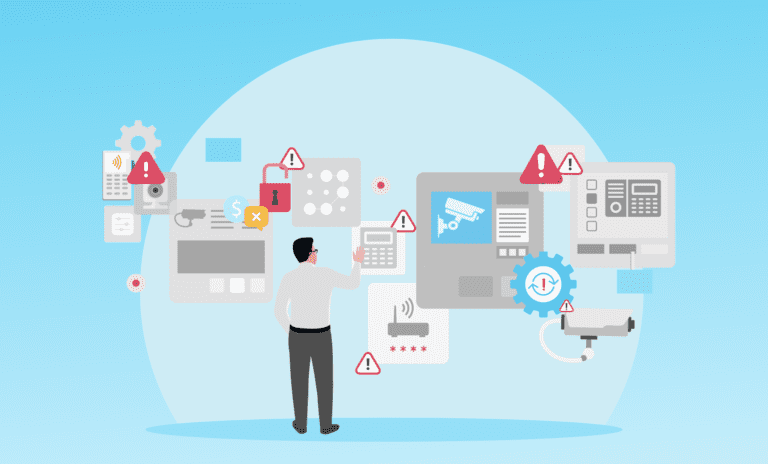
Today’s physical security teams increasingly rely on advanced devices and systems to protect their organizations, such as IP cameras, access control systems, alarms, sensors, etc. And with good reason, considering how effectively these devices can help to prevent crimes and catch perpetrators efficiently.
However, as helpful as these types of technology can be, they also come with a few unique risks; specifically, cybercriminals can often target these devices. Cyberattacks on physical security devices can have wide-ranging repercussions, causing severe legal, reputational, and financial harm.
And it’s not just organizations’ cybersecurity that’s at risk. When an organization’s physical security devices have cyber vulnerabilities, hackers can carry out cyberattacks and compromise the organization’s physical security.
To prevent these dangers from hurting your organization, it’s important to understand the risks and what’s at stake. With that in mind, here’s a look at six of the most severe ways hackers can wreak havoc on physical security devices.
1. Gaining control of a device
Perhaps the most alarming way hackers can degrade an organization’s physical security is by gaining complete control of a physical security device.
When a device isn’t properly secured, hackers can accomplish this goal in various ways, causing a wide variety of problems. For example, if they gain control of an access control system such as a smart lock, they could give bad actors easy access to a sensitive physical location, block those who should have access or both.
This scenario can also present a risk of ransomware attacks. Should hackers gain full control of an organization’s access control system, they could stop the system from working until they are paid a sum of money.
In addition, there is a risk that hackers could use malware to create a botnet running on an organization’s fleet of physical security devices. Then, they could use this botnet to carry out various crimes and attacks against that organization or against third parties (or both).
2. Crashing a device
If hackers overwhelm a physical security device with data (such as through a buffer overflow or DDoS attack), they can cause it to crash.
When this happens, the result is downtime, during which the affected physical security device does not function. This scenario can help criminals carry out on-site crimes without devices such as cameras and access control systems getting in their way.
Hackers can also cause downtime in other ways. For example, in early 2022, a ransomware cyberattack cut off internet access to a New Mexico jail, temporarily making automatic doors and security cameras unusable and forcing the facility to go on lockdown.
3. Accessing a device feed
Physical security devices such as cameras can access sensitive information and transmit much of it online. If hackers manage to access a physical security device’s feed, they can compromise the privacy of employees, customers, and others.
Importantly, this is a scenario that has happened in the past.
If consumers’ personal information is breached because an organization hasn’t correctly protected its physical security devices, that organization could face severe legal and financial consequences. The stakes can be especially high in light of the consumer privacy laws passed in the past decade, such as the GDPR.
4. Modifying a device feed
A similar threat comes from the risk of a man-in-the-middle attack in which hackers intercept data from a physical security device and then modify it.
This can create both physical security and cybersecurity risks. For example, if hackers can alter the feed from an IP camera, they could use that ability to help criminals carry out on-site crimes physically without getting caught.
Organizations can be especially vulnerable to this type of cyberattack if their physical security devices’ feeds are unencrypted.
5. Compromising usernames and passwords
When hackers infiltrate physical security devices, there is a risk that they could access usernames and passwords – a danger that could affect not just these devices but a wide variety of other devices and systems.
That’s because it’s common for organizations’ employees to reuse passwords across multiple devices and accounts. Although this is not the best practice, many users take this shortcut to reduce the number of passwords they need to remember.
As a result, when hackers get their hands on physical security devices’ usernames and passwords, they can obtain credentials that give them access to any number of other systems. Then, they can use credential stuffing to identify these systems, allowing them to cause significant harm in various ways.
6. Infiltrating a network
Perhaps the greatest purely cyber danger posed by connected physical security devices comes from the risk of lateral movement. If your physical security devices are not adequately secured and your network infrastructure isn’t adequately segmented, hackers could use them to break into your network.
If this happens, the consequences could go beyond your physical security devices and jeopardize your organization’s cybersecurity more generally. In other words, the devices meant to protect your organization from (physical) threats can become a vector for (cyber) threat actors to cause a data breach.
This scenario could have far-reaching implications and become extremely costly for targeted organizations. According to IBM’s Cost of a Data Breach Report 2024, the average data breach in the U.S. now costs $9.36 million.
How automated device management protects physical security devices
The dangers highlighted in this post make it especially important to maintain and monitor physical security devices properly. Device maintenance is critical in patching cyber vulnerabilities, allowing for secure (encrypted) communication, and protecting physical security devices from hackers. Meanwhile, monitoring devices around the clock enables physical security teams to find out quickly if their connected devices are targeted.
The problem is that this combination of maintenance and monitoring is such a time-consuming challenge that organizations are not typically able to do it comprehensively. This is largely because of the scale and variety of many organizations’ fleets of physical security devices. Given the conventional, manual approach that many physical security teams still use to manage their connected devices, even relatively basic processes—such as device hardening, password rotations, firmware upgrades, and certificate management—can easily become massive projects.
The most effective way to protect physical security devices from these risks is by taking an automated, comprehensive approach to device management. This way, physical security teams can keep their devices running consistently and securely without becoming overwhelmed by the required work. Meanwhile, they can increase the dependability of their approach to managing physical security devices by preventing human error while streamlining their device management, helping them cut costs.
In other words, taking an automated and comprehensive approach to device management empowers physical security teams to protect their devices from hackers – reliably, efficiently, and cost-effectively.
For a deeper look at cyberprotecting your physical security devices, download our white paper, The 7 Essentials for Cyber-Protecting Physical Security.




